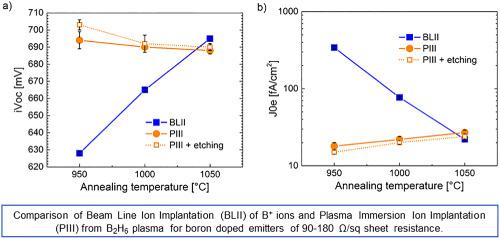当前位置:
X-MOL 学术
›
Prog. Photovoltaics
›
论文详情
Our official English website, www.x-mol.net, welcomes your
feedback! (Note: you will need to create a separate account there.)
Plasma‐immersion ion implantation: A path to lower the annealing temperature of implanted boron emitters and simplify PERT solar cell processing
Progress in Photovoltaics ( IF 8.0 ) Pub Date : 2019-08-19 , DOI: 10.1002/pip.3186 Adeline Lanterne 1, 2 , Thibaut Desrues 1, 2 , Coralie Lorfeuvre 1, 2 , Marianne Coig 1, 3 , Frank Torregrosa 4 , Frédéric Milési 1, 3 , Laurent Roux 4 , Sébastien Dubois 1, 2
Progress in Photovoltaics ( IF 8.0 ) Pub Date : 2019-08-19 , DOI: 10.1002/pip.3186 Adeline Lanterne 1, 2 , Thibaut Desrues 1, 2 , Coralie Lorfeuvre 1, 2 , Marianne Coig 1, 3 , Frank Torregrosa 4 , Frédéric Milési 1, 3 , Laurent Roux 4 , Sébastien Dubois 1, 2
Affiliation

|
Ion implantation is a suitable and promising solution for the massive industrialization of boron doping, which is a crucial process step for most next‐generation solar cells based on crystalline silicon (c‐Si). However, the use of ion implantation for boron doping is limited by the high temperature (in the 1050°C range) of the subsequent activation anneal, which is essential to dissolve the boron clusters and reach a high‐emitter quality. In this work, we propose the use of plasma‐immersion ion implantation (PIII) from B2H6 gas precursor instead of the standard beamline ion implantation (BLII) technique to decrease this temperature down to 950°C. PIII and BLII boron emitters were compared with annealing temperatures ranging from 950°C to 1050°C. Contrary to BLII, no degradation of the emitter quality was observed with PIII implants annealed at 950°C along with a full activation of the dopants in the emitter. At 1000°C, emitter saturation current densities (J0e) below 21 fA/cm2 were obtained using the PIII technique regardless of the tested implantation doses for sheet resistances between 110 and 160 Ω/sq. After metallization steps, the metal/emitter contact resistances were assessed, indicating that these emitters were compatible with a conventional metallization by screen‐printing/firing. The PIII boron emitters' performances were further tested with their integration in n‐type passivated emitter rear totally diffused (PERT) solar cells fully doped by PIII. Promising results already show a conversion efficiency of 20.8% using a lower annealing temperature than with BLII and a reduced production cost.
中文翻译:

等离子体浸没离子注入:降低注入的硼发射体的退火温度并简化PERT太阳能电池工艺的途径
离子注入是硼掺杂大规模工业化的合适且有希望的解决方案,对于大多数基于晶体硅(c-Si)的下一代太阳能电池来说,离子注入是至关重要的工艺步骤。但是,离子注入在硼掺杂中的使用受到后续激活退火的高温(在1050°C范围内)的限制,这对于溶解硼团簇并达到高发射极质量至关重要。在这项工作中,我们建议使用B 2 H 6中的等离子体浸没离子注入(PIII)气体前驱物代替标准的束线离子注入(BLII)技术将温度降低到950°C。将PIII和BLII硼发射极与950°C至1050°C的退火温度进行了比较。与BLII相反,在950°C退火的PIII注入物以及发射极中掺杂物的完全活化下,未观察到发射极质量的下降。在1000°C下,发射极饱和电流密度(J 0e)低于21 fA / cm 2无论使用何种注入剂量,对于110至160Ω/ sq的薄层电阻,都可以使用PIII技术获得。经过金属化步骤后,评估了金属/发射极的接触电阻,表明这些发射极通过丝网印刷/烧结与传统的金属化工艺兼容。通过将PIII硼发射体集成在完全被PIII掺杂的n型钝化发射极后方全扩散(PERT)太阳能电池中,进一步测试了PIII硼发射体的性能。有希望的结果已经表明,使用比BLII更低的退火温度和降低的生产成本,转化效率为20.8%。
更新日期:2019-08-19
中文翻译:

等离子体浸没离子注入:降低注入的硼发射体的退火温度并简化PERT太阳能电池工艺的途径
离子注入是硼掺杂大规模工业化的合适且有希望的解决方案,对于大多数基于晶体硅(c-Si)的下一代太阳能电池来说,离子注入是至关重要的工艺步骤。但是,离子注入在硼掺杂中的使用受到后续激活退火的高温(在1050°C范围内)的限制,这对于溶解硼团簇并达到高发射极质量至关重要。在这项工作中,我们建议使用B 2 H 6中的等离子体浸没离子注入(PIII)气体前驱物代替标准的束线离子注入(BLII)技术将温度降低到950°C。将PIII和BLII硼发射极与950°C至1050°C的退火温度进行了比较。与BLII相反,在950°C退火的PIII注入物以及发射极中掺杂物的完全活化下,未观察到发射极质量的下降。在1000°C下,发射极饱和电流密度(J 0e)低于21 fA / cm 2无论使用何种注入剂量,对于110至160Ω/ sq的薄层电阻,都可以使用PIII技术获得。经过金属化步骤后,评估了金属/发射极的接触电阻,表明这些发射极通过丝网印刷/烧结与传统的金属化工艺兼容。通过将PIII硼发射体集成在完全被PIII掺杂的n型钝化发射极后方全扩散(PERT)太阳能电池中,进一步测试了PIII硼发射体的性能。有希望的结果已经表明,使用比BLII更低的退火温度和降低的生产成本,转化效率为20.8%。











































 京公网安备 11010802027423号
京公网安备 11010802027423号